AAS Session 328: Black Holes I, January 6th
The debate of whether or not a supermassive black hole (SMBH) was
kicked out of the centre of a galaxy continues in the Black Holes I
session at the AAS. According to Stefanie Komossa and her team at the Max Plank Institute for extraterrestrial Physics (MPE) back in May 2008,
spectroscopic data of a galactic core appeared to show a collision
event between two SMBHs. In this case, the smaller SMBH was propelled
out of its host galaxy by an intense and focused "superkick" by
gravitational waves.
However, the delegates attending Session 328 have other ideas…
Click to continue…
With No Smoke or Mirrors, Spacecraft Hunts for Active Galaxies with Central Black Holes
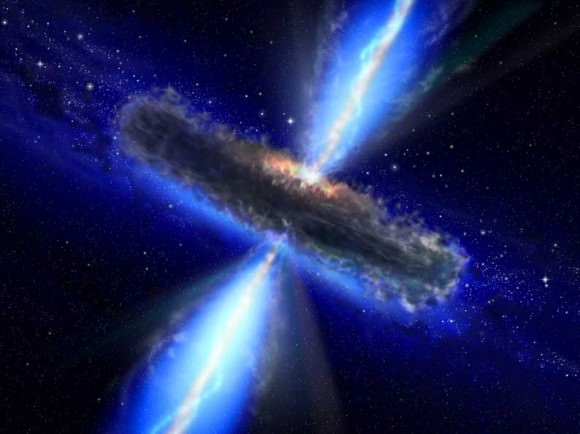
Swift's
Hard X-ray Survey offers the first unbiased census of active galactic
nuclei in decades. Dense clouds of dust and gas, illustrated here, can
obscure less energetic radiation from an active galaxy's central black
hole. High-energy X-rays, however, easily pass through. Credit:
ESA/NASA/AVO/Paolo Padovani
NASA's Swift spacecraft is designed to hunt for gamma-ray bursts. But
in the time between these almost-daily cosmic explosions, Swift's Burst
Alert Telescope (BAT) scans the sky, performing an ongoing X-ray survey. Some of the
first results of that survey were shared at the American Astronomical
Society meeting in Long Beach, California. The BAT is revealing
differences between nearby active galaxies and those located about
halfway across the universe. Understanding these differences will help
clarify the relationship between a galaxy and its central black hole.
But unlike most telescopes,
the BAT observations are not done with mirrors, optics or direct
focusing. Instead, images are made by analyzing the shadows cast by
52,000 randomly placed lead tiles on 32,000 hard X-ray detectors. And
BAT is becoming a workhorse: The survey is now the largest and most
sensitive census of the high-energy X-ray sky.
Click to continue…
Podcast: How Old is the Universe?
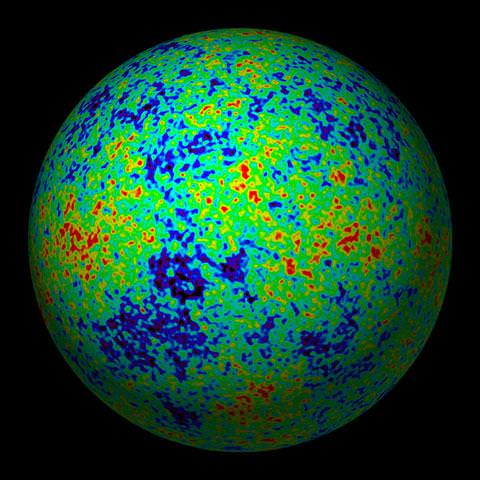
WMAP image of the Cosmic Microwave Background Radiation
We did a wildly popular three part series about the center, size and shape of the Universe. But every good trilogy needs a 4th episode. This week
we look at age of the Universe. How old is the Universe, and how do we
know? And how has this number changed over time as astronomers have
gotten better tools and techniques?
Click here to download the episode.Or subscribe to: astronomycast.com/podcast.xml with your podcatching software.
How Old is the Universe? - Transcript and show notes.
Molecules in Gamma-Ray Burst Detected
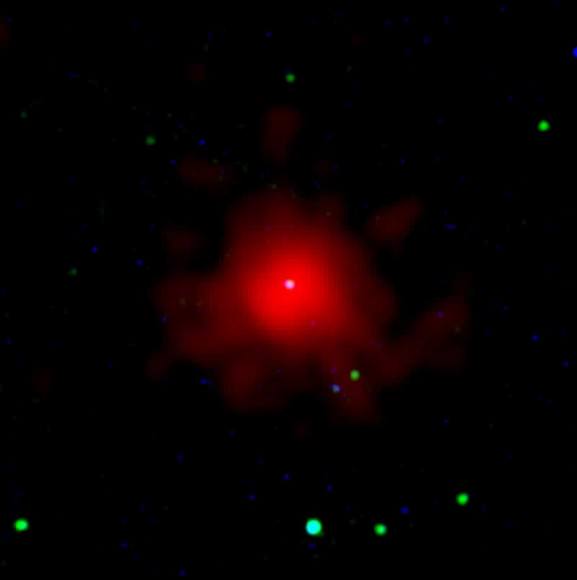
This
image merges Swift optical (blue, green) and X-ray views of GRB 080607.
The white spot at center is the burst’s optical afterglow. Credit:
NASA/Swift/Stefan Immler
Gamma-ray bursts are the universe's most brilliant events, and now
astronomers have been able to shed light on the composition of these
spectacular phenomena, providing insight into star formation when the
universe was about one-sixth its present age. Combining data from
NASA's Swift satellite, the W. M. Keck Observatory in Hawaii, and other
facilities astronomers have, for the first time, identified gas
molecules in the host galaxy of a gamma-ray burst. "We clearly see
absorption from two molecular gases: hydrogen and carbon monoxide.
Those are gases we associate with star-forming regions in our own
galaxy," said Xavier Prochaska, from the University of California Santa
Cruz. He and his team believe that the burst exploded behind a thick
molecular cloud similar to those that spawn stars in our galaxy today.
Click to continue…
Cassiopeia A Comes Alive in 3-D Movies
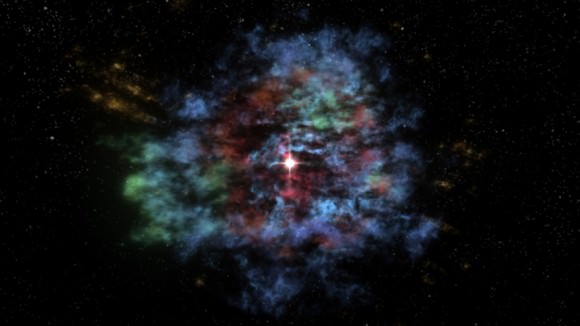
Want to know what it's like to fly through a supernova remnant? Then, THIS, you have to see. You'll be able to experience SNR Cassiopeia A (Cas A)
as never before, and see it across both time and space. Another time lapse animation shows the remnant's expansion and changes over time, and still another provides a 3-D model of Cas A.
Click to continue… Almost ten years ago, Chandra's "First Light" image of Cas A revealed
previously unseen structures and detail, and now, after eight years of
observation, scientists have been able to construct these incredible
animations which were presented at today's American Astronomical
Society meeting in Long Beach, California.
New Ares Construction "Towers" Over 39B
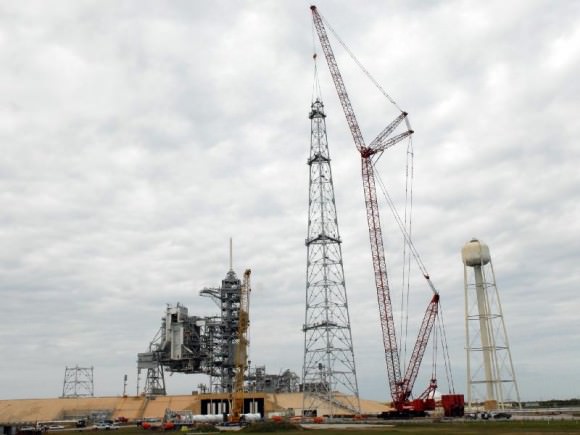
On
Launch Pad 39B at NASA's Kennedy Space Center, a crane completes
construction of one of the towers in the new lightning protection
system for the Constellation Program. Credit: NASA
Things are a-changing over at the Kennedy Space Center launch complex.
The first lightning tower for the Ares rockets has been completed,
dwarfing all the other structures on pad 39B. The tower is for the new
lightning protection system for the Constellation Program. Other towers
are being constructed at left and behind the service structures on the
pad. Each of the three new lightning towers will be 152 meters (500
feet) tall with an additional 30 meter (100-foot) fiberglass mast atop
supporting a catenary, or overhead wire system. This compares to the
height of the shuttle Fixed Service Structure at 105.7 meters (347ft)
to the top of the lightning mast. The new and improved lightning
protection system allows for the taller height of the Ares I rocket
compared to the space shuttle. Pad 39B will be the site of the first
Ares vehicle launch, including the Ares I-X test flight that is
targeted for July 2009. See image below for what the completed system
will look like.
Click to continue…
www.universetoday.com
~~~~~~~~~~~~~~~~~~~~~~~~~~~~~~~~~~~~~~~~~~~
NEW-CYCLE SUNSPOT: The first sunspot of the new year has appeared.
Sunspot 1010 in the sun's southern hemisphere is a member of new
Solar Cycle 24. Readers, if you have a solar
telescope, take a look and witness sunspot genesis in action.
POWER GRIDS IN PERIL: The National Academy of Sciences has released
an important new report detailing how geomagnetic storms could damage
the infrastructure of modern society. An area of particular vulnerability
is power grids. Ground currents induced during century-class storms
can melt the huge, multi-ton transformers at the heart of power
distribution systems. Because modern power grids are interconnected,
a cascade of failures could sweep across the country, rapidly cutting
power to tens or even hundreds of millions of people:
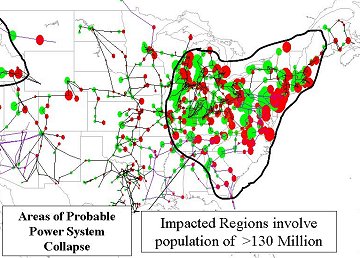
According to the report, "impacts would be felt on interdependent
infrastructures with, for example, potable water distribution affected
within several hours; perishable foods and medications lost in 12-24
hours; immediate or eventual loss of heating/air conditioning, sewage
disposal, phone service, transportation, fuel resupply and so on."
Melted transformers can take months to repair or replace--so a single
extreme storm could make itself felt long after solar activity subsides.
Nothing, it seems, is immune from space weather. (audio)
Full report: Severe
Space Weather Events--Understanding Societal and Economic Impacts (National Academy of Sciences)
ICE HALOS: Clouds vex astronomers, but they're not always a bad thing. "The
same high clouds that prevented me from seeing more Quadrantid
meteors on the night of Jan. 3rd created a beautiful display
of ice halos when the sun came up in the morning," reports
Mila Zinkova of San Francisco, Californa.
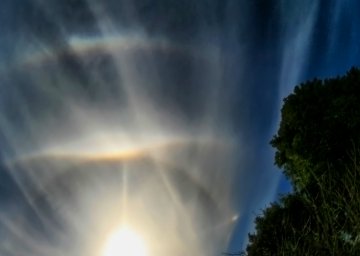
Among the network of arcs and loops, Zinkova identified "a
22o halo, a 46o halo, a Parry arc, an upper
tangent arc and a sundog. I captured them all using my Canon
Digital Rebel XTi."
So, the next time vexacious clouds drift overhead, look around
the sun. You may be pleased with what you see.
www.spaceweather.com



I love the ice halo pic and the whole subject of ice halos....certainly pretty and amazing to see, but just darn pretty amazing!
A lot of info here, all worth taking in.